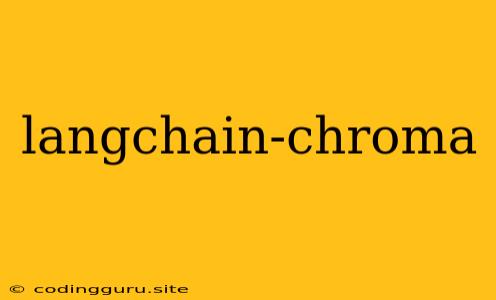LangChain-Chroma: A Powerful Duo for Building Intelligent Applications
In the realm of building intelligent applications, efficient information retrieval and processing are crucial. LangChain and Chroma emerge as powerful tools in this domain, offering a seamless integration for developers to build robust applications that leverage the power of large language models (LLMs). But how exactly does this duo work, and what are its potential applications? Let's delve into the intricacies of LangChain-Chroma and explore its capabilities.
What is LangChain?
LangChain is an open-source framework that provides a standardized way to interact with and chain together LLMs. It empowers developers to build applications that can access external data sources, perform complex reasoning, and execute actions in the real world. LangChain excels at creating chains of thought, enabling seamless integration with external data sources like databases, APIs, and documents.
What is Chroma?
Chroma is an open-source Python library built specifically for building scalable and performant semantic search applications. It utilizes vector databases to store and query data based on its meaning, rather than literal keyword matching. This enables Chroma to handle complex searches and retrieve information that is semantically relevant to the user's query.
How does LangChain-Chroma work?
The magic of LangChain-Chroma lies in their synergistic integration. LangChain serves as the orchestrator, providing the structure and control flow for interacting with LLMs and accessing external data. Chroma, on the other hand, acts as the efficient and powerful data retrieval engine. This integration empowers developers to build applications that can:
- Ingest and store diverse data sources: Chroma can efficiently handle various data formats, including text documents, code snippets, and even audio and video.
- Embed data into vector representations: Chroma transforms data into numerical vectors, capturing the semantic meaning of the content.
- Perform semantic search: Chroma utilizes these vectors to conduct similarity searches, retrieving data that is semantically related to the user's query.
- Chain together LLMs and data sources: LangChain seamlessly integrates with Chroma, allowing developers to access and utilize the retrieved data within their LLM-powered applications.
Potential Applications of LangChain-Chroma
The combination of LangChain and Chroma unlocks a wide range of possibilities across different industries. Here are some potential applications:
- Building AI-powered chatbots: LangChain-Chroma can power chatbots that can understand and respond to user queries in a natural, human-like manner. By integrating with external knowledge bases and using Chroma for efficient data retrieval, chatbots can provide accurate and relevant information.
- Creating intelligent document search systems: Organizations can leverage this duo to create powerful search systems that can understand the content of documents and retrieve relevant information based on semantic similarity.
- Developing personalized recommendation engines: LangChain-Chroma can be used to build recommendation systems that understand user preferences and provide personalized suggestions based on their past interactions and interests.
- Powering code generation applications: Chroma can store and retrieve relevant code snippets, while LangChain can use these snippets to generate new code based on user input.
How to Get Started with LangChain-Chroma
Getting started with LangChain-Chroma is relatively straightforward. Here are the steps you can follow:
-
Install the necessary libraries:
pip install langchain chroma -
Initialize Chroma:
from chromadb.api import Client client = Client( path="chroma_db", # Local path to store the database embedding_function="openai", # Use OpenAI's embedding model ) -
Ingest data into Chroma:
collection = client.get_or_create_collection("my_collection") collection.add( documents=["This is a document.", "Another document with more text."], metadatas=[{"source": "Document 1"}, {"source": "Document 2"}], ids=["doc1", "doc2"], ) -
Use LangChain to interact with Chroma:
from langchain.embeddings.openai import OpenAIEmbeddings from langchain.vectorstores import Chroma from langchain.chains import RetrievalQA embeddings = OpenAIEmbeddings() vectorstore = Chroma(client=client, embedding_function=embeddings) retriever = vectorstore.as_retriever() qa = RetrievalQA.from_chain_type(llm=OpenAI(), chain_type="stuff", retriever=retriever) print(qa.run("What is in document 2?"))
Conclusion
LangChain-Chroma is a powerful combination that empowers developers to build intelligent applications capable of understanding and responding to user queries in a natural and meaningful way. This duo provides a robust framework for integrating LLMs with external data sources, enabling developers to build innovative applications across various industries. As both LangChain and Chroma continue to evolve, we can expect even more exciting applications to emerge, driving the future of intelligent applications.
